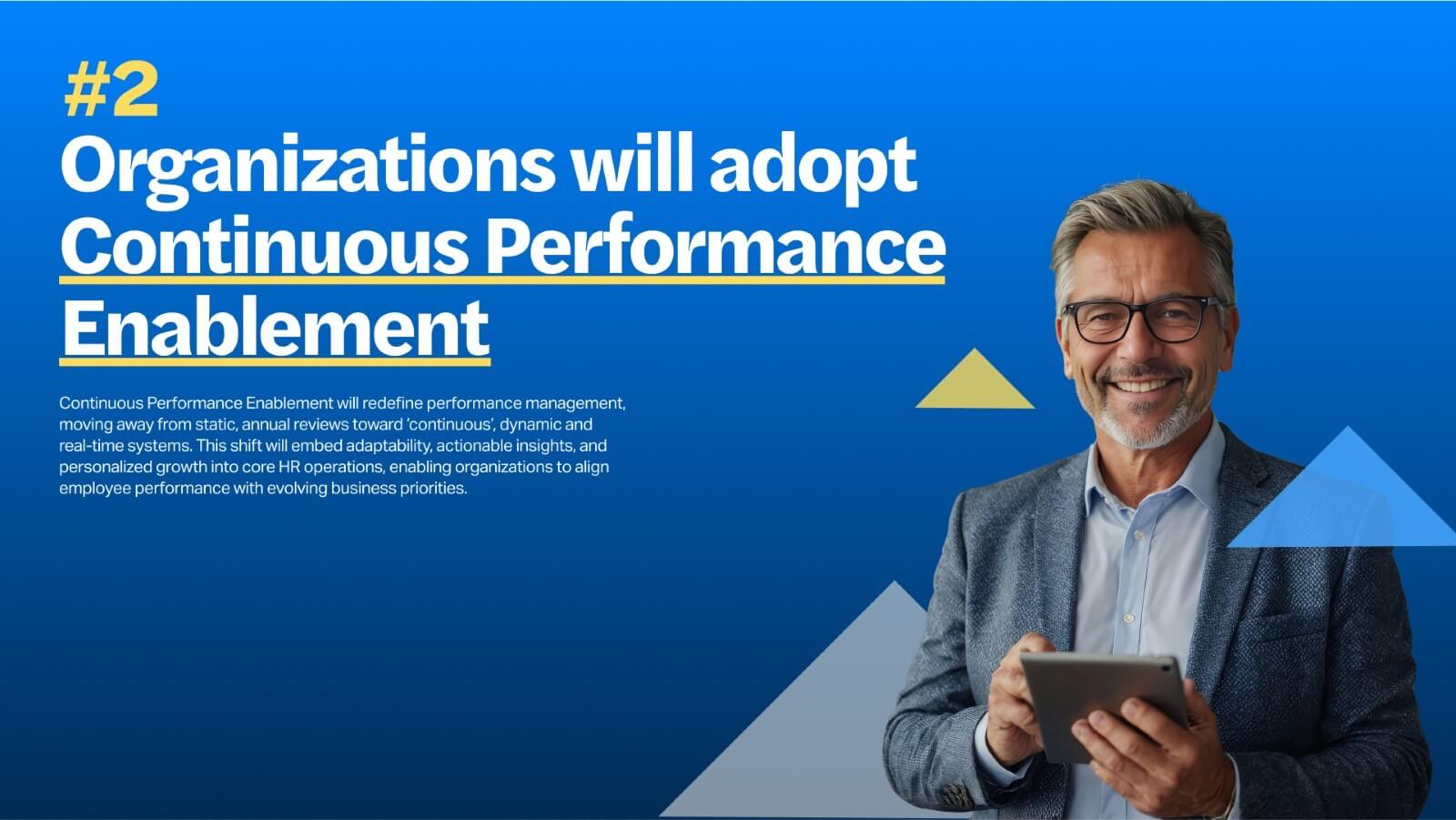

The traditional performance management playbook, anchored in annual reviews, top-down goal-setting, and retrospective feedback is rapidly becoming obsolete. In a fast-changing world of work, organizations need a performance framework that’s agile, employee-centric, and embedded in real time. Enter Continuous Performance Enablement, which is an emerging HR tech trend in 2025 that reimagines how organizations manage and maximize performance.
Rather than measuring performance at fixed intervals, performance enablement is a continuous, dynamic, and forward-looking system. It combines real-time insights, ongoing feedback, and personalized growth to ensure that employee performance stays aligned with evolving business goals. This shift empowers HR leaders, people managers, and employees alike with data-driven tools to drive clarity, motivation, and accountability turning performance into a strategic advantage rather than a compliance task.
The Five Core Pillars of Performance Enablement
The shift to continuous performance enablement is not about a single tool or tactic; it’s a holistic reimagining of how organizations inspire, guide, and grow their talent. This transformation is anchored in five foundational pillars that are reshaping the very fabric of performance management. Each pillar addresses long-standing limitations of traditional systems, while infusing agility, data intelligence, and personalization into everyday workflows.
Let’s explore how these 5 pillars are enabling modern organizations to align people performance with business priorities, while empowering individuals to thrive:
-
Real-Time Feedback: Closing the Feedback Gap Before It Widens
Feedback is most powerful when it's timely, relevant, and actionable. Yet, in most traditional systems, feedback is sporadic delivered too late, too vaguely, or from too narrow a perspective. This results in disengaged employees and misses opportunities for course correction.
The Problem:
- Delayed annual reviews offer little value in real time
- Feedback is inconsistent, lacking structure and impact
- Employees often feel unseen and unsupported between review cycles
The Shift:
Modern performance enablement tools now integrate real-time, multi-stakeholder feedback systems powered by AI. These platforms:- Prompt managers to share feedback at critical milestones
- Notify employees for self-reflection and peer input
- Capture a 360-degree view of performance over time
- Offer sentiment-based insights to elevate the quality of feedback
The Impact:
- 72% of managers say real-time AI feedback improves employee performance and engagement
- Employees are 2.1x more likely to perceive reviews as fair with AI-supported systems
- Organizations implementing these tools report up to a 30% increase in engagement
-
Goal Setting and Alignment: Keeping Pace with a Moving Target
In dynamic business environments, goals can shift rapidly. Yet, traditional systems still rely on rigid, annual objectives that become outdated within months. This misalignment leaves employees unclear about priorities and disconnected from the big picture.
The Problem:
- Annual goal setting is too static and infrequent
- Goals often lack visibility, structure, or connection to team/company vision
- Employees feel misaligned or directionless in fast-changing contexts
The Shift:
AI is revolutionizing goal setting by enabling dynamic, responsive, and cascading goal frameworks. Today’s systems:- Allow goals to evolve alongside shifting strategies
- Connect individual objectives to team and organizational OKRs
- Offer AI-assisted goal suggestions to ensure clarity and measurability
- Track goal progress in real time, reducing ambiguity
The Impact:
- 32% of organizations using AI-aligned objectives report higher goal success rates
- Businesses adopting continuous goal setting show greater agility and workforce alignment.
-
Performance Journals: Capturing Growth in Real Time
Employees achieve countless wins over a year—but many go unnoticed due to a lack of documentation. Without a system to capture milestones and feedback in the moment, performance reviews become subjective and incomplete.
The Problem:
- Achievements and contributions are easily forgotten between cycles
- Managers struggle to recall performance accurately
- Employees feel undervalued when their growth goes unrecognized
The Shift:
Digital performance journals powered by AI are changing how progress is documented and reviewed. These tools:- Allow employees to log key wins, learning moments, and feedback
- Feed into dashboards for transparent tracking
- Support managers with summarized insights during review discussions
- Encourage employees to reflect on their journey proactively
The Impact:
- Fosters a culture of ownership and recognition
- Reduces performance review bias by anchoring discussions in evidence
- Strengthens the manager-employee relationship through transparent dialogue
-
360-Degree Feedback: Broadening the Lens on Performance
True performance cannot be assessed in isolation. Yet most legacy systems rely solely on manager feedback overlooking valuable input from peers, subordinates, and cross-functional collaborators.
The Problem:
- One-dimensional feedback lacks nuance and credibility
- Peer and team contributions are often underrepresented
- Reviews are prone to unconscious bias and blind spots
The Shift:
AI-enabled platforms now facilitate automated, structured 360-degree feedback. This includes:- Collecting feedback from multiple stakeholders with minimal friction
- Using sentiment analysis to extract depth and emotional tone
- Analyzing patterns to uncover strengths and development opportunities
The Impact:
- Creates a more inclusive and holistic view of performance
- Reduces bias, boosting fairness and employee trust
- Helps identify quiet high-performers and unsung contributors
-
Individual Development Plans (IDPs): Personalizing the Growth Journey
Employees want more than checkboxes; they want to grow, thrive, and evolve within the organization. But generic, static development plans don’t reflect individual strengths, aspirations, or potential.
The Problem:
- One-size-fits-all L&D paths lead to disengagement
- Development plans often sit unused, with no clear direction or ownership
- Lack of alignment between personal goals and business needs
The Shift:
AI-powered platforms are ushering in a new era of personalized, dynamic IDPs. These systems:- Identify skill gaps and align them with current/future role requirements
- Recommend targeted learning resources, mentorships, and mobility options
- Evolve over time as employees progress and the business landscape shifts
The Impact:
- 20% of organizations leveraging AI-driven IDPs report higher retention of top performers
- Employees feel more supported, motivated, and future-ready
- HR gains data-driven insights to map talent to opportunity more effectively
Together, these five pillars form the foundation of a modern performance strategy that doesn’t just measure past behavior but actively enables growth, engagement, and alignment in real time. To learn more about the impact of continuous performance enablement over traditional performance management, download Top 10 HR Tech Trends Report 2025
Strategic Value of Performance Enablement for HR, Managers, and Business Leaders
While often perceived as a functional HR initiative, Performance Enablement is increasingly recognized as a core business strategy one that impacts employee experience, productivity, and organizational agility. When implemented thoughtfully, it drives value across all levels of the enterprise, from frontline managers to C-suite executives.
Let’s look at how performance enablement tools and strategies are delivering meaningful impact across three key personas: Business Leaders, HR Leaders, and HR Managers/People Leaders.
🎯 For Business Leaders: Enabling Strategic Alignment and Agility
In today’s volatile business environment, leadership teams need clear, real-time visibility into workforce performance to drive smarter decisions and stay agile. Performance enablement platforms provide business leaders with:
- Live dashboards that track performance trends, team health, and goal progress
- AI-powered insights to monitor workforce ROI, flag performance risks, and identify high-potential talent
- Cross-functional alignment tools that connect employee efforts to broader strategic outcomes
- This real-time intelligence supports faster, data-backed decision-making, empowering business leaders to pivot quickly, allocate resources more effectively, and monitor the success of strategic initiatives in real time.
- 32% of organizations report enhanced business agility through the use of AI-powered performance systems (Deloitte, 2024)
👥 For HR Leaders: Driving Fairness, Engagement, and Workforce Impact
Performance enablement positions HR as more than just a compliance or support function, it transforms HR into a strategic architect of culture, development, and engagement. HR leaders can now:
- Leverage AI-driven analytics to reduce bias in performance evaluations and ensure consistency across the board
- Use performance data to identify organizational health trends and implement targeted engagement interventions
- Champion a culture of continuous development by aligning feedback, learning, and mobility with business goals
- The ability to act on data instead of just collecting it gives HR leaders a seat at the decision-making table, enabling them to drive workforce strategies that fuel growth.
- 68% of HR leaders have observed increased engagement and fairness after adopting continuous, AI-enabled feedback systems (Deloitte, 2024)
🤝 For HR Managers & People Leaders: Streamlining Conversations and Empowering Growth
For HR managers and people leaders on the ground, performance enablement tools serve as everyday enablers of clarity, communication, and connection. These tools help managers to:
- Simplify performance conversations with real-time data, smart prompts, and feedback summaries
- Automate repetitive tasks like attendance logging, feedback collection, and goal updates freeing up time for coaching and development
- Foster transparency and trust through 360-degree feedback loops, performance journals, and sentiment analysis
- This combination of visibility and automation empowers people managers to be more effective mentors, not just evaluators strengthening team cohesion and individual satisfaction.
- 78% of managers say AI-powered feedback has enhanced the quality of their interactions and improved employee satisfaction (LinkedIn Workplace Learning Report, 2024)
Where Are Organizations Investing in Performance Enablement?
The performance enablement landscape is evolving rapidly, with organizations increasingly integrating AI into their people strategies especially at the intersection of performance, learning, and retention. According to the industry insights curated in the Top 10 HR Tech Trends Report 2025, here’s where leading enterprises are placing their bets:
- 90% of organizations are investing in AI-powered L&D programs to boost retention and prepare employees for future roles
- 4 out of 5 employees want to learn how to use AI tools in their roles underscoring the link between tech fluency and job satisfaction
- 47% of companies are deploying AI-enabled career mentoring and coaching initiatives to support internal mobility
- 70% of employees report feeling more connected to their organization through ongoing upskilling and reskilling programs
- 87% of HR managers believe that aligning learning with business goals is essential for long-term workforce performance
These numbers make it clear: performance enablement is the foundation for retention, engagement, and growth in 2025 and beyond. Organizations that invest in intelligent, continuous systems are positioning themselves to lead—not lag—in the future of work.
Final Thoughts
In 2025, performance enablement isn’t a “nice to have” - it’s a strategic necessity. Organizations that embrace real-time feedback, continuous learning, and personalized growth pathways are better positioned to:
- Drive engagement and retention
- Build agile, high-performing teams
- Align workforce performance with business strategy
By embedding AI into every touchpoint of performance from feedback to development planning HR leaders can move from managing performance to enabling potential.
📥 Ready to reimagine performance in your organization? Explore how Darwinbox is powering continuous performance enablement through AI-driven solutions, real-time insights, and personalized experiences.
👉 Download our full report: Top 10 HR Tech Trends Report 2025
Let’s build a future where every employee is seen, supported, and set up for success.



Speak Your Mind